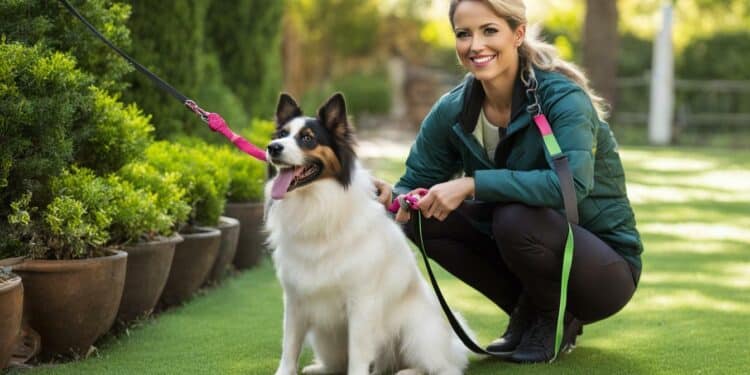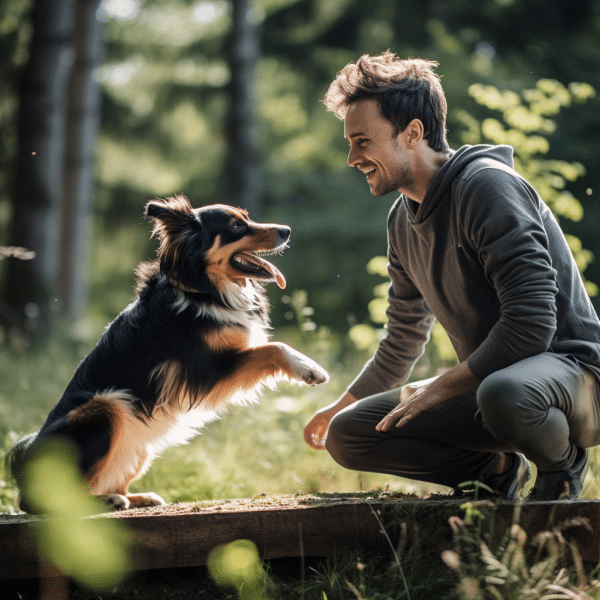Top Dog Trainers and Their Effective Training Methods

Dog Training Methods: Need the best dog trainers in the U.S. for your pup? We’ve got you covered! This article explores top trainers and their successful methods. They use a variety of techniques, including positive reinforcement and relationship-based approaches. Positive reinforcement rewards good behavior with treats, praise, and affection. This approach avoids punishment and force, focusing on creating a positive experience for your dog.
Scientific training techniques are another key component of effective dog training. These methods are grounded in the understanding of dog behavior and psychology, relying on evidence-based approaches to achieve desired results. By incorporating principles of learning theory and behavior modification, these trainers can effectively shape and modify dog behavior in a humane and ethical manner.
The best dog trainers use clicker training to reward good behavior. This involves a small device that makes a noise to detect exemplary dog behavior. Dogs learn faster and better with this method. However, some trainers use electric collars, fences, and remote trainers, but these may not prioritize dog safety and well-being.
Another effective technique is model-rival training, where top dog trainers demonstrate desired behaviors with a model dog. This helps dogs learn by watching and imitating. Today, many dog trainers emphasize trust, communication, and partnership over coercion. Open communication and positive reinforcement build strong dog-owner relationships, enhancing conduct and teamwork.
When choosing a dog trainer, consider their experience, qualifications, and approaches. Trust a trainer who shares your goals and ideals. Professional dog training can significantly improve your relationship and life with your dog. Good trainers correct behavior and teach obedience. Finding the best dog trainers can improve behavior and bonding between you and your furry friend.
Importance of Professional Dog Trainers

Hiring a professional dog trainer can make all the difference in transforming your pet into an obedient and well-behaved companion. When it comes to training your dog, it’s essential to work with certified and experienced trainers who have the necessary qualifications and expertise. Professional trainers have a deep understanding of dog behavior and psychology, allowing them to create effective training programs tailored to your dog’s specific needs.
One of the primary advantages of working with professional dog trainers is their ability to utilize a wide range of training methods. These trainers are well-versed in positive reinforcement techniques, where rewards and positive reinforcement are used to encourage desired behaviors. They prioritize creating a safe and supportive environment for your dog, helping them learn and grow without unnecessary stress or fear.
Experienced trainers also employ scientifically-based training methods that are backed by evidence. They stay up to date with the latest research and developments in dog training, ensuring they provide the most effective and humane techniques. By using these scientifically-backed methods, professional trainers can address behavioral issues and help your dog overcome challenges while strengthening the bond between you and your furry friend.
The Qualities of a Good Professional Dog Trainer
| Qualities | Description |
|---|---|
| Patience | A good dog trainer understands that every dog learns at their own pace, and patience is key to successful training. |
| Communication | Clear and effective communication is essential between the trainer, the dog, and the owner to ensure consistent and successful training. |
| Empathy | Being able to empathize with a dog’s needs and emotions helps trainers create a positive and supportive training environment. |
| Flexibility | A skilled trainer adapts their approach to suit each individual dog’s personality, learning style, and specific training goals. |
| Passion | A passion for working with dogs and a genuine love for the training process are characteristics of a great dog trainer. |
In conclusion, professional dog trainers play a crucial role in helping you and your furry companion achieve success in training. Their expertise, methods, and dedication ensure that your dog receives the best possible training experience, leading to a happy, well-behaved, and obedient pet. By investing in professional training, you can strengthen your bond with your dog and create a harmonious relationship built on trust, communication, and mutual understanding.
Understanding Different Training Methods
Top dog trainers employ various training methods to teach dogs good behavior and obedience. These methods are designed to address specific behavioral issues and create a strong bond between the dog and its owner. Understanding these different training methods can help you choose the approach that best fits your dog’s needs and your training goals.
Positive Reinforcement Training
One widely recognized training method is positive reinforcement. This approach focuses on rewarding desired behaviors to encourage their repetition. Trainers use treats, toys, and verbal praise as positive reinforcements, teaching dogs to associate good behavior with positive outcomes. Positive reinforcement training is highly effective and emphasizes creating a positive and enjoyable training experience for the dog.
Scientific Training Techniques
Another approach used by top dog trainers is scientific training. This method relies on evidence-based techniques grounded in an understanding of dog behavior and psychology. By applying scientific principles, trainers can modify unwanted behaviors and teach new skills efficiently. Scientific training techniques often involve using rewards, shaping, and targeting specific behaviors to achieve desired results.
Clicker Training
Clicker training is a popular method employed by top dog trainers. This technique uses a small handheld device called a clicker to mark desired behaviors. The sound of the clicker serves as a clear and consistent signal for the dog, indicating that they have performed the desired action. Clicker training is effective in teaching dogs new behaviors and can be combined with positive reinforcement for optimal results.
Electronic Training Tools
In some cases, top dog trainers may use electronic training tools to supplement their training methods. These tools include electronic collars, electronic fences, and remote trainers. While controversial, when used correctly and ethically, these tools can provide effective training solutions for certain behavioral issues. It is important to note that proper training and guidance from a knowledgeable professional are crucial when incorporating electronic training tools.
| Training Method | Description |
|---|---|
| Positive Reinforcement Training | Focused on rewarding desired behaviors to encourage repetition. |
| Scientific Training Techniques | Evidence-based techniques grounded in an understanding of dog behavior and psychology. |
| Clicker Training | Uses a clicker as a marker to indicate desired behaviors. |
| Electronic Training Tools | Includes electronic collars, fences, and remote trainers for specific training needs. |
By familiarizing yourself with these different training methods, you can make an informed decision when selecting a dog trainer. Remember that each approach has its strengths and limitations, and finding the right fit for your dog is key to achieving successful outcomes. Whether you choose positive reinforcement, scientific training, clicker training, or a combination of methods, the ultimate goal is to strengthen the bond with your dog and foster a harmonious and well-behaved companion.
Positive Reinforcement Training
Positive reinforcement training is one of the most effective methods used by top dog trainers to shape desirable behaviors in dogs. This approach focuses on rewarding and reinforcing positive behaviors, rather than punishing or correcting unwanted behaviors. By using rewards such as treats, praise, and play, trainers encourage dogs to repeat behaviors that are desired, making the learning process enjoyable for both the dog and the owner.
One of the key principles of positive reinforcement training is to establish clear communication with the dog. Trainers use cues, hand signals, and verbal commands to convey expectations to the dog. When the dog responds correctly, it is immediately rewarded, reinforcing the desired behavior. This method helps dogs understand what is expected of them and empowers them to make the right choices.
A crucial aspect of positive reinforcement training is consistency. It is essential for owners to be consistent in their cues, rewards, and expectations. This helps the dog understand the desired behaviors across different situations and reinforces their learning. With patience, repetition, and consistency, positive reinforcement training can create lasting behavioral changes in dogs.
It is important to note that positive reinforcement training is based on scientific research and understanding of dog behavior. Trainers who use this method prioritize the welfare of the dog and focus on building a positive and trusting relationship. They work with the individual needs and personality of each dog, tailoring the training program accordingly. By using positive reinforcement, dogs can learn new behaviors, overcome fears and anxieties, and develop good manners.
| Benefits of Positive Reinforcement Training |
|---|
| 1. Creates a positive learning environment |
| 2. Strengthens the bond between dog and owner |
| 3. Builds confidence and trust in the dog |
| 4. Reduces stress and anxiety |
| 5. Helps address behavioral issues |
The Power of Positive Reinforcement
“Positive reinforcement training is not only effective but also humane. It focuses on rewarding dogs for good behavior, rather than resorting to punishment or force. By using positive reinforcement, we create an environment where dogs are eager to learn and are motivated to please their owners. It is a win-win situation for both the dog and the human.” – Professional Dog Trainer
- Positive reinforcement training relies on rewards such as treats, praise, and play to motivate dogs.
- It is an enjoyable and stress-free approach to training that fosters a positive relationship between dog and owner.
- This method can be used to teach basic obedience commands, address behavioral issues, and even train dogs for specific tasks or sports.
When searching for a dog trainer, look for professionals who prioritize positive reinforcement training and have experience using this method. By working with a trainer who understands the principles of positive reinforcement, you can give your dog the best chance of learning and thriving.
A Word of Caution
While positive reinforcement training is highly effective, it is important to remember that every dog is unique. Some dogs may have specific challenges or require different training approaches. A skilled trainer will assess your dog’s individual needs and tailor the training program accordingly. They will have a repertoire of training techniques and methods to address various behavioral issues.
| Key Points to Remember |
|---|
| 1. Positive reinforcement training is an effective and humane method used by top dog trainers. |
| 2. It focuses on rewarding desired behaviors to shape positive habits. |
| 3. Consistency and clear communication are important for successful training. |
| 4. Positive reinforcement training creates a positive learning environment and strengthens the bond between dog and owner. |
Scientific Training Techniques
Top dog trainers rely on scientific training techniques to ensure a systematic and effective approach to dog training. These techniques are rooted in the understanding of dog behavior and psychology, and they prioritize the use of evidence-based methods that are humane and safe.
One key aspect of scientific training is positive reinforcement. Trainers use rewards, such as treats or praise, to reinforce desired behaviors in dogs. By associating these rewards with specific actions, dogs learn to repeat those behaviors in order to receive the positive reinforcement.
In addition to positive reinforcement, scientific training techniques also involve understanding and addressing the underlying causes of behavioral issues. Trainers work to identify the root causes of a dog’s problematic behaviors, whether it’s fear, anxiety, or lack of socialization. By addressing these underlying issues, trainers can help dogs overcome their behavioral challenges and develop more appropriate responses.
| Scientific Training Techniques | Description |
|---|---|
| Positive Reinforcement | Uses rewards to encourage desired behaviors |
| Behavior Modification | Addresses underlying causes of behavioral issues |
| Counter Conditioning | Replaces negative associations with positive ones |
A key principle of scientific training is that it focuses on building a strong bond between the dog and the owner. Trainers prioritize trust, clear communication, and mutual respect in their interactions with dogs. This relationship-based approach not only enhances the effectiveness of training but also promotes a positive and harmonious relationship between the dog and their owner.
In conclusion, scientific training techniques employed by top dog trainers offer a systematic and evidence-based approach to dog training. These techniques prioritize positive reinforcement, address the underlying causes of behavioral issues, and prioritize the building of a strong bond between the dog and owner. By utilizing these methods, trainers can effectively train dogs and improve the overall quality of life for both the dog and their owner.
Clicker Training
Skilled trainers use clicker training to communicate with dogs and reinforce good behavior. The method involves a small device called a clicker that makes a distinct sound when pressed. The click signals to the dog that they did something right and is followed by a reward.
The clicker helps trainers communicate with dogs clearly and consistently. This makes it easier for dogs to understand what is expected of them. Clicking the clicker and rewarding dogs with treats or praise helps dogs associate the sound with positive outcomes. Clicker training is versatile and can teach a wide range of behaviors. The clicker provides instant feedback, which speeds up the learning process. It can also be used with other training methods to enhance the training experience.
| Benefits of Clicker Training |
|---|
| Clear communication with the dog |
| Quick and effective learning |
| Can be used for various behaviors and tasks |
| Can be combined with other training methods |
In conclusion, clicker training is a powerful and widely utilized method employed by top dog trainers. By using clickers as a marker for desired behaviors and reinforcing positive associations, trainers can effectively communicate with dogs and achieve remarkable results. Whether you are teaching basic obedience commands or advanced tricks, clicker training offers a rewarding and efficient approach to dog training.
Electronic Training Tools
Electronic training tools can be effective aids in the hands of experienced dog trainers to reinforce commands and manage behavior. These tools are designed to provide additional support in training sessions, ensuring better communication and understanding between the trainer and the dog.
One commonly used electronic training tool is the electronic collar, also known as an e-collar or shock collar. This device delivers a mild electric stimulation to the dog as a form of correction or reinforcement. When used responsibly and under the guidance of a professional trainer, the e-collar can help address behavioral issues such as excessive barking or disobedience.
Another popular electronic training tool is the electronic fence, which uses radio frequency signals or wireless technology to create a boundary for the dog. The dog wears a special collar that emits a warning tone or mild static correction when they approach the designated boundary. Electronic fences are effective in keeping dogs within a specific area without the need for physical barriers.
| Pros | Cons |
|---|---|
| Can provide consistent and immediate feedback | Should only be used under the guidance of a professional trainer |
| Can be a valuable tool for off-leash training | Misuse or improper use can lead to negative consequences |
| Allows for precise and controlled correction | May not be suitable for all dogs or training needs |
It is important to note that electronic training tools should always be used responsibly and with the dog’s well-being in mind. Trainers who utilize these tools should have the necessary experience, knowledge, and understanding of dog behavior to ensure their safe and effective use. Effective training methods, including the use of electronic tools, prioritize positive reinforcement, trust, and communication to achieve long-lasting behavioral changes and strengthen the bond between dog and owner.
Model-Rival Training Approach
Model-rival training is a technique utilized by skilled dog trainers to teach dogs through observation and imitation. This method involves introducing a well-trained model dog that exhibits desired behaviors, serving as a role model for the dog being trained. Through repetitive exposure and positive reinforcement, the dog learns to mimic the model dog’s actions and behaviors. This approach is particularly effective for dogs who learn best through social learning and imitation.
During model-rival training, the trainer acts as a neutral observer, allowing the dog to focus solely on the model dog’s behavior. By observing the model dog’s actions and receiving positive reinforcement when emulating those behaviors, the dog begins to understand and replicate the desired actions. Model-rival training can be especially useful for teaching complex tasks or advanced obedience commands.
It is important to note that model-rival training should be conducted by experienced and knowledgeable trainers. They have the expertise to select appropriate model dogs and ensure the safety and well-being of the dogs involved. When done correctly, model-rival training can be a highly effective method to teach dogs, fostering learning through observation and imitation.
| Benefits of Model-Rival Training: |
|---|
| 1. Teaches dogs through social learning and imitation. |
| 2. Helps dogs learn complex tasks or advanced obedience commands. |
| 3. Encourages positive behavior through repetitive exposure and positive reinforcement. |
| 4. Enhances the bond between dog and trainer through targeted training sessions. |
Alpha Dog or Dominance Training
Alpha dog or dominance training has been utilized by some dog trainers, however it can hurt the dog. This training assumes dogs are pack animals that need a leader. Harsh tactics include physical punishment, leash corrections, and alpha rolls.
Alpha dog or dominance training can lead to fear, anxiety, and aggression in dogs. It can damage the trust and bond between the dog and the owner, as well as negatively affect the dog’s mental and emotional well-being.
AVSAB and other groups discourage alpha dog/dominance training. They suggest positive reinforcement and relationship-based methods. Training should be tailored to each dog. Consult a certified professional trainer who uses humane techniques for your dog’s well-being.
Table: Comparison of Different Training Methods
| Training Method | Approach | Benefits |
|---|---|---|
| Positive Reinforcement | Using rewards and positive reinforcement to encourage desired behaviors | Creates a happy and well-trained dog; strengthens the bond between dog and owner |
| Scientific Training Techniques | Grounded in the understanding of dog behavior and psychology | Provides effective and evidence-based training; fosters understanding between dog and owner |
| Clicker Training | Using a clicker as a marker for desired behaviors and reinforcement | Aids in clear communication and quick learning; enhances the dog-owner relationship |
| Model-Rival Training Approach | Using a model dog to demonstrate desired behaviors and encourage imitation | Facilitates learning through observation and imitation; promotes obedience and cooperation |
| Relationship-Based Training | Emphasizes positive reinforcement, trust, and communication for long-lasting behavioral changes | Strengthens the bond between dog and owner; establishes a foundation of mutual respect |
By choosing positive and relationship-based training methods, you can foster a harmonious and fulfilling relationship with your dog. Remember, effective training is not about dominance or control but about understanding, trust, and building a strong partnership based on love and respect.
Relationship-Based Training
Relationship-based training is a holistic approach embraced by top dog trainers to foster a strong bond and enhance communication between dogs and their owners. This method emphasizes building trust and understanding, focusing on positive reinforcement rather than aversive techniques. By prioritizing rewards and positive associations, trainers can encourage desired behaviors while addressing behavioral issues in a humane and effective manner.
One key aspect of relationship-based training is the emphasis on understanding dog behavior. Trainers who follow this approach have a deep understanding of canine psychology and use scientifically-backed techniques to modify behaviors. They recognize that each dog is unique and adapt their methods to suit the specific needs and temperament of the individual dog.
This approach also places great importance on the relationship between the dog and the owner. Trainers guide owners on how to communicate effectively with their dogs, teaching them how to interpret and respond to their pet’s behaviors in a positive and constructive way. Through relationship-based training, dogs learn to trust their owners and feel secure, which ultimately leads to better obedience and a happier, well-rounded pet.
| Benefits of Relationship-Based Training | Key Features |
|---|---|
|
|
“Relationship-based training is all about nurturing a strong and healthy bond between you and your furry friend. It’s about understanding their needs and finding positive ways to address their behaviors. By prioritizing the relationship, you’ll not only have a well-trained dog but also a loving and loyal companion.”
Finding Top Dog Trainers Near You
When searching for the best dog trainer near you, it is important to consider factors like their qualifications, experience, and training methods. Choosing the right trainer can make a significant difference in the success of your dog’s training journey and the overall relationship between you and your furry companion.
Start by doing thorough research and gather recommendations from friends, family, or local pet organizations. Online directories and review platforms can also provide valuable insights into the reputation and track record of dog trainers in your area.
Once you have a list of potential trainers, dig deeper into their qualifications and experience. Look for certifications or credentials from reputable organizations such as the Certification Council for Professional Dog Trainers. This ensures that the trainer has undergone rigorous training and met specific standards in the industry.
| Qualifications | Experience | Training Methods |
|---|---|---|
| CPDT-KA, ABCDT | 10+ years working with various breeds | Positive reinforcement, clicker training |
| CCPDT-KA, KPA-CTP | 5+ years specializing in behavioral issues | Scientific training, relationship-based training |
| APDT, CPDT-KA | 15+ years training working dogs | Model-rival training, positive reinforcement |
Lastly, pay close attention to the trainer’s training methods. Different trainers may specialize in various approaches, so it’s essential to find one that aligns with your goals and values. Popular methods like positive reinforcement and relationship-based training emphasize using rewards and positive reinforcement to motivate your dog and build a strong bond. These humane and scientifically-backed techniques have proven to be effective in achieving long-lasting behavioral changes.
By taking the time to research and select a reputable dog trainer who uses effective training methods, you can set your beloved pup up for success and foster a harmonious relationship built on trust, understanding, and positive reinforcement.
Improving the Bond with Your Dog
Professional dog training not only enhances your dog’s behavior but also deepens the bond and connection between you and your furry companion. By enrolling your dog in a relationship-based training program, you can establish trust, improve communication, and create a harmonious partnership.
In relationship-based training, trainers prioritize positive reinforcement and reward-based methods. This approach focuses on building a strong bond between you and your dog, fostering mutual respect and understanding. By using rewards such as treats, praise, and play, you can reinforce desired behaviors and help your dog learn and respond positively.
During the training sessions, trainers encourage you to actively participate and engage with your dog. This involvement not only helps strengthen the bond but also allows you to understand your dog’s needs, body language, and individual quirks. Through consistent training and positive interactions, you can establish a solid foundation of trust and create a loving and cooperative relationship with your dog.
| Benefits of Relationship-Based Training |
|---|
| 1. Strengthened bond and trust between you and your dog |
| 2. Improved communication and understanding of your dog’s needs |
| 3. Enhanced obedience and responsiveness to commands |
| 4. Reduced stress and anxiety for both you and your furry friend |
By prioritizing relationship-based training, you can achieve long-lasting results and a harmonious partnership with your dog. Remember, a well-trained and happy dog is not only a joy to be around but also a reflection of the strong bond you share.
Achieving Lasting Results
To get long-term outcomes, reinforce top dog trainers’ training approaches in your regular contacts with your dog. Training requires consistency and a set routine to reinforce desirable actions. Trainers’ methods can assist your dog grasp expectations and reinforce good behavior.
Rewarding training is beneficial. Positive reinforcement shapes your dog’s behavior. Reward your dog with goodies, praise, or playtime for desirable behavior. This strengthens the link between action and reward, making your dog more inclined to repeat the activity. Keep your rewards consistent and lower their frequency as your dog improves.
Key Tips for Achieving Lasting Results:
Another important aspect of achieving lasting results is to continue practicing training exercises regularly. This helps maintain the learned behaviors and reinforces them over time. Set aside dedicated time each day to work on training exercises with your dog. Focus on specific commands or behaviors that you want to reinforce, such as sit, stay, or walking on a leash. By consistently practicing these exercises, your dog will become more confident and reliable in responding to your cues.
| Key Tips for Achieving Lasting Results: |
|---|
| 1. Consistency is key – Stick to a structured routine that reinforces desired behaviors. |
| 2. Use rewards – Positive reinforcement helps strengthen the connection between desired behaviors and rewards. |
| 3. Practice regularly – Set aside time each day to work on training exercises with your dog. |
| 4. Be patient – Rome wasn’t built in a day, and training takes time. Stay consistent and patient with your dog. |
Lastly, remember to be patient. Training takes time, and it is important to remain consistent and patient with your dog. Some behaviors may take longer to master than others, but by continuing to reinforce the training methods taught by top dog trainers, you can achieve lasting results. Building a strong bond based on trust, communication, and positive reinforcement will not only enhance your dog’s behavior but also strengthen the relationship between you and your furry companion.

Conclusion
Pick a good dog trainer to make your pet behave well. You can choose from different training methods like positive reinforcement or clicker training. Positive reinforcement trainers give rewards for good behavior. They build trust between you and your dog for lasting results.
Good dog trainers use proven methods based on understanding dog behavior and psychology. This creates a positive learning environment for your dog. When choosing a trainer, look for someone with experience, certification, and a focus on your dog’s welfare. This will help you achieve great results and strengthen your bond with your pet.
FAQ
Q: What are the different training methods used by top dog trainers?
A: Top dog trainers use various methods such as positive reinforcement, scientific training, clicker training, electronic training, model-rival training, alpha dog or dominance training, and relationship-based training.
Q: What is positive reinforcement training?
A: Positive reinforcement training is a popular method where trainers use rewards and positive reinforcement to encourage desired behaviors in dogs.
Q: What are scientific training techniques?
A: Scientific training techniques are evidence-based approaches that rely on understanding dog behavior and psychology to achieve effective training.
Q: How does clicker training work?
A: Clicker training involves using a clicker as a marker to reinforce positive behaviors and create positive associations in dogs.
Q: How do electronic training tools work?
A:Dog training aids can include electronic collars, fences, and remote trainers, all of which deliver stimuli and feedback to the dog in a regulated fashion.
Q: What is model-rival training?
A: The purpose of model-rival training is to get the dog to act like a “model” dog.
Q: What is alpha dog or dominance training?
A: Alpha dog or dominance training is a controversial method that emphasizes establishing dominance over the dog. It is gradually being replaced by more positive and relationship-based training methods.
Q: What is relationship-based training?
A: Relationship-based training focuses on building a strong bond between the dog and the owner. It prioritizes positive reinforcement, trust, and communication to achieve long-lasting behavioral changes.
Q: How can I find top dog trainers in my area?
A: To find top dog trainers in your area, it is important to research and consider factors such as qualifications, experience, and training methods.
Q: How can professional dog training improve the bond with my dog?
A: Professional dog training helps improve the bond between dog and owner by enhancing communication, understanding, and overall quality of life for both.
Q: How can I achieve lasting results with dog training?
A: Consistent and ongoing training, along with practicing the techniques learned from professional trainers, is key to achieving lasting results with dog training.






